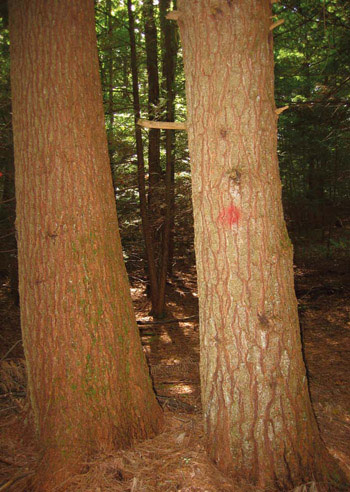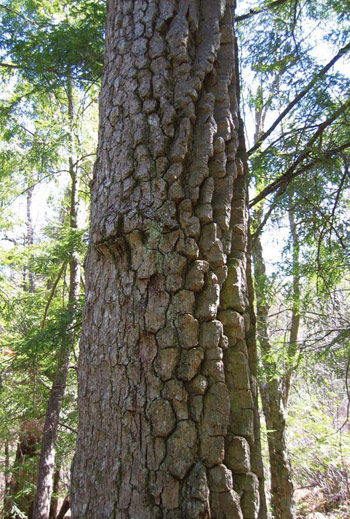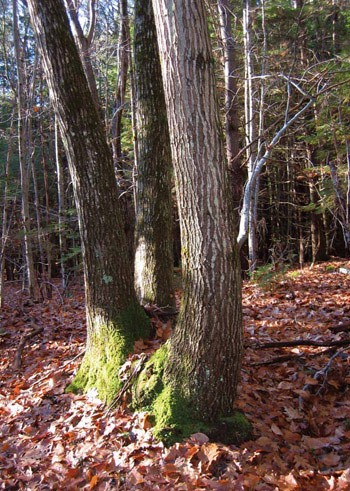In last winter’s issue, we highlighted a 400- year-old hemlock tree that was only 20 inches in diameter; in a recent web feature, we went the other way and marveled at a 70-year-old red oak that was a whopping 32 inches across. The disparity highlights the fact that guessing the age of a standing tree can be a humbling experience; in practice, diameter is a good first clue, but it’s certainly not the whole story.
Tom Wessels, author of Reading the Forested Landscape: A Natural History of New England, has recently completed a companion book Forest Forensics: A Field Guide to Reading the Forested Landscape. In this excerpt, he gives some pointers on how to age a standing tree without the aid of an increment borer.
Rough estimates of tree age can be made based on diameter and bark texture. For canopy trees growing on moderate sites (in terms of moisture and nutrient levels), at one foot in diameter they will be about 50 years of age and at two feet, about 100 years of age. But there are many exceptions to this rule, listed below:
• Canopy-suppressed trees or trees growing on dry, nutrient-poor sites will grow more slowly and be older at the above diameters.
• Open-grown trees or trees growing on moist, nutrient-rich sites will grow faster and be younger at the above diameters.
• Upland trees such as tulip tree, white pine, red oak, and white ash grow faster than other species, so they will be younger at the above diameters.
• Alluvial flood plain species such as silver maple, sycamore, eastern cottonwood, and American elm grow quite fast and are often half the age at the above diameters.
• Multiple-trunked trees will be older at the above diameters since the root system is supporting a number of trunks. The greater the number of trunks, the slower each puts on trunk diameter (see picture A).
By calculating the basal area of each of the trunks and combining them, one can calculate the basal area of a single combined trunk to estimate when the cutting of the original tree occurred. As an example, imagine a tree with three trunks, each 8 inches in diameter. Using the formula area=3.14 x radius squared, each trunk would have a basal area of 50 square inches (3.14 x 16), so all three trunks combined would have a total of 150 square inches of basal area. Reversing the formula, 150 square inches gives a radius of 7 inches or a trunk diameter of 14 inches if the three trunks were merged. A 14-inch-diameter tree is roughly equivalent to 60 years, which dates the time of cutting of this tree.
Within a species, individual trees produce the same thickness of bark each year. However, the amount of wood they produce is variable based on growing conditions or age. Fast-growing trees that lay down wide annual growth rings will stretch their bark, giving it a less rough appearance, while on slow-growing trees the bark can build up to a very rough appearance (see picture B).

(B) Younger, fast-growing pine on left is larger than the older, slow-growing pine at right.
If the trunk of the tree is leaning, you should examine the portion of the trunk that faces the ground. This is where you will find the representative bark of the tree. On many species of trees, such as white oak, ash, white pine, hemlock, maple, birch, black gum, and others supporting bark ridges, the bark on skyward facing portions of the trunk can capture wet snow. When the wet snow freezes and expands, it can exfoliate the bark, making it appear less rough than is typical of the species. Whenever estimating tree age by diameter, also examine the bark texture to see if it is rougher or smoother than might be expected for the tree’s size and then adjust your estimate of age either up or down (see picture C).

(C) Two-faced black gum.
Excerpt and images reprinted courtesy of Tom Wessels and the Countryman Press.



Discussion *